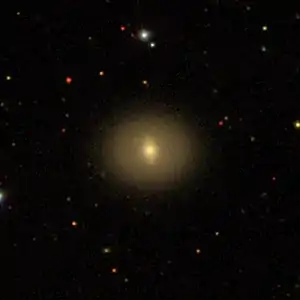NGC 3266
NGC 3266 ist eine linsenförmige Galaxie vom Hubble-Typ SB0 im Sternbild Großer Bär am Nordsternhimmel. Sie ist schätzungsweise 83 Millionen Lichtjahre von der Milchstraße entfernt.
| Galaxie NGC 3266 | |
|---|---|
 | |
| SDSS-Aufnahme | |
| AladinLite | |
| Sternbild | Großer Bär |
| Position Äquinoktium: J2000.0, Epoche: J2000.0 | |
| Rektaszension | 10h 33m 17,6s[1] |
| Deklination | +64° 44′ 58″[1] |
| Erscheinungsbild | |
| Morphologischer Typ | SAB0^0^[1][2] |
| Helligkeit (visuell) | 12,5 mag[2] |
| Helligkeit (B-Band) | 13,5 mag[2] |
| Winkelausdehnung | 1,4′ × 1,2′[2] |
| Positionswinkel | 105°[2] |
| Flächenhelligkeit | 12,9 mag/arcmin²[2] |
| Physikalische Daten | |
| Rotverschiebung | 0.005887 ± 0.000040[1] |
| Radialgeschwindigkeit | (1765 ± 12) km/s[1] |
| Hubbledistanz vrad / H0 |
(83 ± 6) · 106 Lj (25,5 ± 1,8) Mpc [1] |
| Geschichte | |
| Entdeckung | Wilhelm Herschel |
| Entdeckungsdatum | 3. April 1791 |
| Katalogbezeichnungen | |
| NGC 3266 • UGC 5725 • PGC 31198 • CGCG 313-022 • MCG +11-13-030 • GC 2125 • H II 871 • h 717 • | |
Das Objekt wurde am 3. April 1791 von Wilhelm Herschel entdeckt.[3]
Weblinks
This article is issued from Wikipedia. The text is licensed under Creative Commons - Attribution - Sharealike. The authors of the article are listed here. Additional terms may apply for the media files, click on images to show image meta data.
